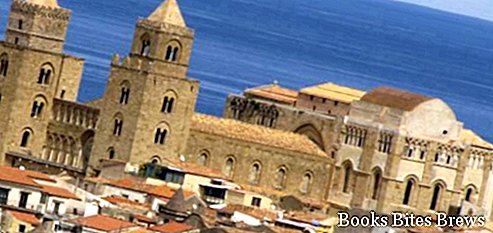What to see in Cefalù, itinerary including the main monuments and places of interest, including the Norman Cathedral, Mandralisca Museum and Pinacoteca.
Tourist information
Located 70 km from Palermo, Cefalù stands on a promontory and a slight slope at the foot of a cliff that drops steeply into the sea, in a very suggestive position, with an extraordinary contrast between sea and rock.
Cefalù, which is part of the Madonie Park, is classified as one of the most beautiful villages in Italy.
The wonderful contrast between rock and sea characterizes the position of the ancient Cephaloedium, a name probably derived from the particular shape of a human head recognizable in the promontory where today's Cefalù stands.
It was dominated by the Greeks, Romans, Byzantines and Normans, with the latter in power the city was enriched with beautiful monuments, including the cathedral which, among the most beautiful in Sicily and wanted by Roger II in 1131, also includes a remarkable adjacent Cloister, the Church of San Giorgio, the washhouse in via Vittorio Emanuele, the Palazzo Maria located in Piazza Duomo, the Osteria Magno on Corso Ruggero, a fortified palace which according to tradition would have been the residence of Ruggero.
Belonging to the Ventimiglia family since 1300, today it serves as an exhibition space for tourism and cultural purposes.
What see
According to a legend, the Cathedral of Cefalu, dating back to the twelfth century, is said to have been built following a vow made by Roger II, king of Sicily, to have survived a shipwreck that caused him to be found on the banks of Cefalu.
Apart from this, it is actually believed that the original function of the building was that of a fortress created to defend itself from attacks from the sea.
The facade characterized by two imposing twin towers, with mullioned windows and pyramidal cusps placed on the top.
The fifteenth-century portico is remarkable, characterized by three arches resting on four columns.
The internal plan is of the Latin cross type, with three naves separated from each other by two rows of columns, some in pink granite, others in cipollino with relative bases and capitals.
Recommended readings- Mazara del Vallo (Sicily): what to see
- Trapani (Sicily): what to see
- Randazzo (Sicily): what to see
- Milazzo (Sicily): what to see
- Sicily: Sunday day trips
Externally the Cathedral has a high transept and three apses with blind arches and small loggias, placed in the upper part, with the rocky wall of the cliff in the background.
Via Mandralisca, the road in front of the Cathedral, leads to the Mandralisca Museum, so named because it collects various types of material that Baron Enrico Piraino of Mandralisca had brought together.
This museum contains an archaeological section, with prehistoric tools and Greek vases, a scientific section, including a collection of over twenty thousand shells, a well-stocked numismatic collection which counts, in addition to the coins minted by the mint of Cefalù, those of the main cities of ancient Sicily .
Also very interesting is the Pinacoteca, also housed inside the museum, which collects various works including the Portrait of the Unknown, by Antonio da Messina, and works by other important artists such as Dionisio Calvaert, Francesco Mieris, Domenico Fetti and Antonello De Saliba.




